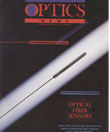
November, 1989 Issue
Feature Articles
Fiber optic gyroscope technology
For over a decade, optical fiber-based interferometric techniques have been investigated for use in rotation sensing. Research began in the mid-1970s when the pioneering work of Vali and Shorthill demonstrated for the first time the application of fiber optics for rotation sensing. This research effort, spawned in a number of laboratories worldwide, was instrumental in bringing about significant advances in a number of component-related areas, especially in polarization maintaining (PM) fiber, PM fiber couplers, fiber polarizers, and sources. The performance of fiber optic gyroscopes improved over the years, with significant progress linked to a number of important developments, such as identification of the need for reciprocity and introduction of the super luminescent diode (SLD), which led to dramatic improvements due to the practical elimination of Rayleigh backscatter noise and drift due to the Kerr effect.
by A.D. Kersey, A. Dandridge, and W.K. BurnsFiber interferometric sensors: Technology and applications
This article will focus on a relatively small but important niche of the field of fiber sensor technology—fiber sensors based on Mach-Zehnder interferometers. Related articles on the fiber gyroscope, on sensors for medical applications, and on multiplexing techniques appear elsewhere in this issue.
by F. Bucholtz and A.M. YurekOptical fiber biosensing
This article focuses on the advantages that fiber sensing offers to the biomedical field and outlines the basic working principles of most fiber biosensors.
by A.M. Scheggi and A.G. MignaniMultiplexing of fiber-optic sensors
Fiber-optic sensors are opening up a variety of applications for the sensing of parameters such as temperature, pressure, strain, acoustic signals, chemical concentration, electric and magnetic fields, rotation, and many others. Some sensors use optical fibers only as a light pipe to deliver optical signals to separate optical sensors; others use optical fibers as a sensing medium as well. In the most sensitive type of fiber-optic sensors, the environmental parameters of interest modify the phase of the optical wave propagating in an optical fiber monitored by interferometric measurements. Interferometric fiber-optic sensors are constructed with single-mode fibers, high birefringence fibers, and two-mode fibers.
by Kim and H.J. ShawFiber optic sensors
Light-based sensing devices allow measurement in adverse environments such as those that contain EMI, microwave, or RF interference and those that are potentially toxic or explosive. The use of light as a sensing technology took a major growth step with the revolutionary application of optical fiber in the telecommunications industry. Ruggedized cable, electro-optic transceiver components, easy-to-use connectors, and installation tools have been perfected for telecommunications applications over the past 10 years. Sensor manufacturers have now incorporated many of these advancements in their product development.
by L.C. GundersonISO sums up standards process
DIS 9849 explains that "ISO (the International Organization for Standardization) is a worldwide federation of national standards bodies (ISO member bodies). The work of preparing International Standards is normally carried out through ISO technical committees. Each member body interested in a subject for which a technical committee has been established has the right to be represented on that committee. Draft International Standards adopted by the technical committees are circulated to the member bodies for approval before their acceptance as International Standards by the ISO Council. They are approved in accordance with ISO procedures requiring at least 75% approval by the member bodies voting." This very neatly summarizes how ISO writes standards and how they are accepted internationally.
by Robert E. Parks
![Infinity Mirrored Room– Brilliance of the Souls 2014 by artist Yayoi Kusama. [© YAYOI KUSAMA]](https://opnmedia.blob.core.windows.net/$web/opn/media/images/articles/2024/0724/departments/202407-cover-web.jpg?ext=.jpg)
![An experimental scheme demonstrated by researchers at Princeton and Yale universities, USA, can convert physical noise into errors that can be corrected more easily. [F. Wojciechowski, Princeton University]](https://opnmedia.blob.core.windows.net/$web/opn/media/images/articles/2024/0624/departments/202406-cover-web.jpg?ext=.jpg)
